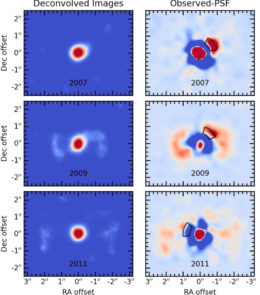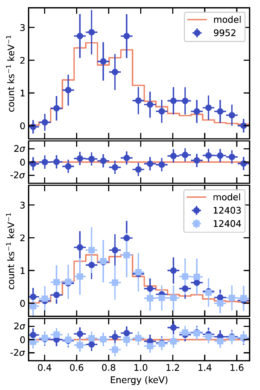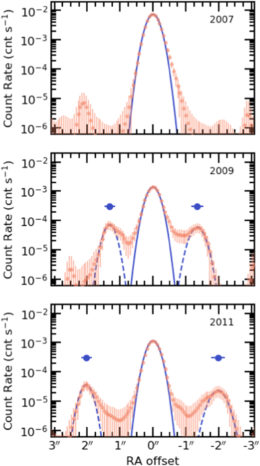A new star appears in the constellation Ophiuchus roughly every 15 years when the surface of a white dwarf ignites in a burst of nuclear fusion. Can X-ray observations tell us what happens in the aftermath of these explosions?
Hello Again, RS Oph

Images of RS Oph obtained after processing. The expanding lobes that extend in the east–west direction are clearly visible in the 2009 and the two 2011 observations, which are combined into one for the analysis. The black outlines indicate the location of a known artifact in the imaging system. [Adapted from Montez et al. 2022]
RS Oph has flared up every 9–21 years since its first recorded explosion in 1898, with the two most recent outbursts occurring in 2006 and 2021. The aftermath of RS Oph’s 2006 eruption has been observed all across the electromagnetic spectrum, revealing an expanding ring of circumstellar material and a massive bipolar outflow. A new article led by Rodolfo Montez Jr. (Center for Astrophysics ∣ Harvard & Smithsonian) introduces X-ray observations from just a few years after the 2006 outburst, giving us an unprecedented view of the system’s expanding outflows.
Expanding Our Knowledge
Montez and collaborators investigated images and spectra taken by the Chandra X-ray Observatory in 2007, 2009, and 2011 to study the X-ray-emitting plasma flowing outward from the white dwarf. They detected jet-like structures spreading out from the system to the east and west, mirroring the structures seen at other wavelengths.
The jets were too close to the RS Oph system to be discernible in 2007, but they grew visibly between 2009 and 2011, traveling across the sky at a rate of 1.1 milliarcseconds per day. The distance to RS Oph is still uncertain, making it difficult to measure the precise velocity of the outflow, but the authors estimate that this apparent movement corresponds to 6,000 kilometers per second — meaning that the material was launched at roughly 2% the speed of light!
No Slowing Down
How did the bipolar jets evolve as they expanded? Based on archival multiwavelength images, the jets appear to have expanded linearly over time, without slowing down. They also appear not to have cooled down; modeling of the X-ray spectra suggests that the outflow maintained a constant temperature of 2 million kelvin.

Model output (orange lines) and data (blue symbols) for the 2009 observations (top panel) and the two 2011 observations (bottom panel). [Montez et al. 2022]
As data trickle in after RS Oph’s most recent flare-up in August 2021, astronomers are already beginning to discern the presence of new outflows. With luck, the next few years will bring many observations of this intriguing system, allowing astronomers to search for new structures that might arise from the latest outburst.
Citation
“Expanding Bipolar X-Ray Structure After the 2006 Eruption of RS Oph,” R. Montez Jr. et al 2022 ApJ 926 100. doi:10.3847/1538-4357/ac4583


